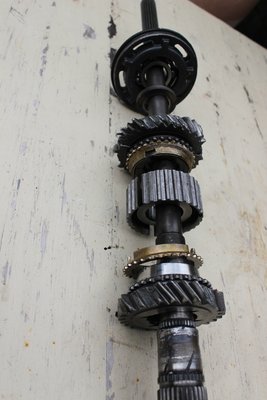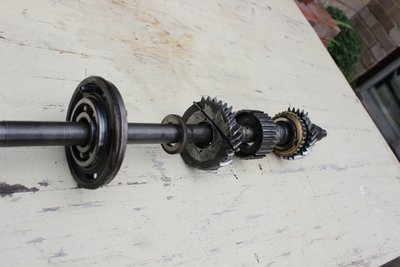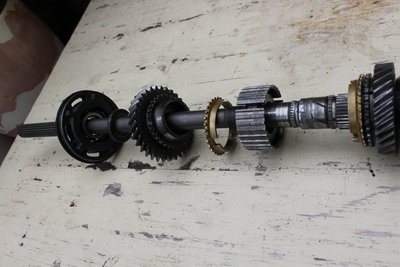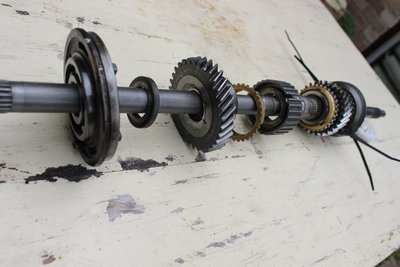2000E semi close 1st gear welding itself to mainshaft
31 posts
• Page 2 of 3 • 1, 2, 3
Hi Chancer
The synchro rings, gears, main shaft and Baulk rings are the original 1967 parts with the only new parts being the Baulk ring springs, lay shaft, lay shaft bearings, main shaft front and rear bearings and oil.
The rings did have a gap to the gear shoulder when built up and could move back and forth when built up, I did not check how much the ring sat back from the tapered end of the gear though and it may have been less than 1/32".
The ring on the first gear shown in the photo became badly damaged during my attempts to press the gear off the shaft using a Sykes gear puller and finally a sledge hammer.
The synchro rings, gears, main shaft and Baulk rings are the original 1967 parts with the only new parts being the Baulk ring springs, lay shaft, lay shaft bearings, main shaft front and rear bearings and oil.
The rings did have a gap to the gear shoulder when built up and could move back and forth when built up, I did not check how much the ring sat back from the tapered end of the gear though and it may have been less than 1/32".
The ring on the first gear shown in the photo became badly damaged during my attempts to press the gear off the shaft using a Sykes gear puller and finally a sledge hammer.
- TrevorJones
- Second Gear

- Posts: 51
- Joined: 21 Jan 2016
At least in Australia genuine original Ford gear box parts have not been available for many years so i would believe it would have been an after market component .
Looking at the photo i agree something was rubbing leading to overheating and finally it seizing on the shaft.
Redline MTL and MT90 gear oils are specifically designed to have the right coefficient of friction characteristics for syncro gear boxes compared to most general purpose modern gear oils .
cheers
Rohan
Looking at the photo i agree something was rubbing leading to overheating and finally it seizing on the shaft.
Redline MTL and MT90 gear oils are specifically designed to have the right coefficient of friction characteristics for syncro gear boxes compared to most general purpose modern gear oils .
cheers
Rohan
-

rgh0 - Coveted Fifth Gear

- Posts: 8413
- Joined: 22 Sep 2003
TrevorJones wrote:Hi Chancer
The synchro rings, gears, main shaft and Baulk rings are the original 1967 parts with the only new parts being the Baulk ring springs, lay shaft, lay shaft bearings, main shaft front and rear bearings and oil.
The rings did have a gap to the gear shoulder when built up and could move back and forth when built up, I did not check how much the ring sat back from the tapered end of the gear though and it may have been less than 1/32".
The ring on the first gear shown in the photo became badly damaged during my attempts to press the gear off the shaft using a Sykes gear puller and finally a sledge hammer.
You didn't confirm which rear bearing carrier and spacer you used? There are two types of each.
What is the spec of the Redline oil? Is it a GL4 or GL5 spec? High sulphur content oils are not good for baulk rings in old Ford boxes as it strips the material off brass/bronze rings. I only recommend GL4 in any gearbox I build.
-

promotor - Fourth Gear

- Posts: 797
- Joined: 16 Mar 2012
He said he used Redline MT90, This is a GL4 oil specifically designed to work with bronze syncro rings. it is however a heavy 75W90 weight rather than the 75w80 original Ford specification which is the Redline MTL specification equivalent. However it is unlikely that the viscosity difference was the cause of the problem as MT90 would flow and lubricate much better than original 75W80 gear oils used.
cheers
Rohan
cheers
Rohan
-

rgh0 - Coveted Fifth Gear

- Posts: 8413
- Joined: 22 Sep 2003
Hi Rohan,
Clearly then one must be fully conversant with all gear oil on offer before moving away from manufactures recommendations.
Ron.
QUOTE.
75W90.
? Most popular Red Line gear oil, with thousands of applications for passenger cars, light trucks, and racing vehicles
? Contains additional friction modifiers for suitablity with clutch-type limited slip differentials - for most LSDs, no additional friction modifiers are required
? This product is not designed for use in most manual transmissions or tranaxles, since the extreme slipperiness may cause synchronizer mesh issues that lead to shifting problems
? Recommended for API GL-5, GL-6, MT-1, MIL-L-2105E, and SAE J2360
ABOUT RED LINE GEAR OIL FOR DIFFERENTIALS
________________________________________
________________________________________
Clearly then one must be fully conversant with all gear oil on offer before moving away from manufactures recommendations.
Ron.
QUOTE.
75W90.
? Most popular Red Line gear oil, with thousands of applications for passenger cars, light trucks, and racing vehicles
? Contains additional friction modifiers for suitablity with clutch-type limited slip differentials - for most LSDs, no additional friction modifiers are required
? This product is not designed for use in most manual transmissions or tranaxles, since the extreme slipperiness may cause synchronizer mesh issues that lead to shifting problems
? Recommended for API GL-5, GL-6, MT-1, MIL-L-2105E, and SAE J2360
ABOUT RED LINE GEAR OIL FOR DIFFERENTIALS
________________________________________
________________________________________
- Craven
- Coveted Fifth Gear

- Posts: 1623
- Joined: 14 Sep 2013
Redline MT90 is different from Redline 75w90 gear oil.
MT90 is the same viscosity specification at 75W90 but it is a GL4 gear oil specifically designed for manual syncro gear boxes. Redline 75W90 Gear Oil is a GL5 gear oil designed for diffs especially hypoid gear diffs like the Elan uses
if you have a transaxle that combines a manual gear box and a hypoid diff in one unit then the selection becomes more difficult Fortunately most trans axles dont use a hypoid diff crownwheel and pinon.
Fortunately most trans axles dont use a hypoid diff crownwheel and pinon.
My Esprit uses a spiral bevel crown wheel and pinion in its diff in the transaxle so I use the GL4 MT 90 which is the specified viscosity and suitable for a manual gearbox and a GL4 oil which is OK for a spiral bevel crown wheel and pinion.
The fundamental difference between a GL4 and GL5 gear oil is that the GL5 oils are designed for sliding in addition to rolling tooth contact. Hypoid diffs have sliding tooth contact. Manual gear boxes have rolling tooth contact. To handle sliding tooth contact the slipperiness needs to be better which makes GL5 oils unsuitable for good syncro engagement. GL5 oils also use higher sulphur levels to achieve the lubrication needed in sliding contact and this sulphur can lead to corrosion of Brass syncro rings when the compounds break down at the high localised heat levels experienced on the points on the syncro rings ridges when engaging gear.
The lubrication world has moved a long way since the Elan was built and unfortunately the changes are not well explained to aid selection of modern superior lubricants.
cheers
Rohan
MT90 is the same viscosity specification at 75W90 but it is a GL4 gear oil specifically designed for manual syncro gear boxes. Redline 75W90 Gear Oil is a GL5 gear oil designed for diffs especially hypoid gear diffs like the Elan uses
if you have a transaxle that combines a manual gear box and a hypoid diff in one unit then the selection becomes more difficult
My Esprit uses a spiral bevel crown wheel and pinion in its diff in the transaxle so I use the GL4 MT 90 which is the specified viscosity and suitable for a manual gearbox and a GL4 oil which is OK for a spiral bevel crown wheel and pinion.
The fundamental difference between a GL4 and GL5 gear oil is that the GL5 oils are designed for sliding in addition to rolling tooth contact. Hypoid diffs have sliding tooth contact. Manual gear boxes have rolling tooth contact. To handle sliding tooth contact the slipperiness needs to be better which makes GL5 oils unsuitable for good syncro engagement. GL5 oils also use higher sulphur levels to achieve the lubrication needed in sliding contact and this sulphur can lead to corrosion of Brass syncro rings when the compounds break down at the high localised heat levels experienced on the points on the syncro rings ridges when engaging gear.
The lubrication world has moved a long way since the Elan was built and unfortunately the changes are not well explained to aid selection of modern superior lubricants.
cheers
Rohan
-

rgh0 - Coveted Fifth Gear

- Posts: 8413
- Joined: 22 Sep 2003
Hi Promotor and guys
I have attached a few photos for your thoughts.
First set show the first time the 1st gear welded itself to the shaft under acceleration but no gear damage, the main overheating was at the rear splined spacer and the rear of the gear.
Second set show the latest 1st gear weld to shaft under acceleration in second with consequent loss of a few teeth on first, second and the lay shaft. The main friction this time seems to be between the front face of the gear and the synchro hub, same result that stopped the car with the 1st gear being friction welded to the shaft.
The oil spec is Red Line Gear Oil Full Synthetic MT-90 GL-4 High Performance lubricant for Manual transmissions & transaxles. SAE 75W90 API GL-4, it claims to improve synchro coefficient of friction, eliminates notchy shift in cold or warm weather etc etc. and seems to be the Dingos %)((*%^.
Something is going wrong with either my setup of the gear, oil or simply the age of all the components under extreme stress condition. I will be changing to a straight cut synchro set up but really welcome LotusElan.net help with what could be the cause of this issue.
Trevor
I have attached a few photos for your thoughts.
First set show the first time the 1st gear welded itself to the shaft under acceleration but no gear damage, the main overheating was at the rear splined spacer and the rear of the gear.
Second set show the latest 1st gear weld to shaft under acceleration in second with consequent loss of a few teeth on first, second and the lay shaft. The main friction this time seems to be between the front face of the gear and the synchro hub, same result that stopped the car with the 1st gear being friction welded to the shaft.
The oil spec is Red Line Gear Oil Full Synthetic MT-90 GL-4 High Performance lubricant for Manual transmissions & transaxles. SAE 75W90 API GL-4, it claims to improve synchro coefficient of friction, eliminates notchy shift in cold or warm weather etc etc. and seems to be the Dingos %)((*%^.
Something is going wrong with either my setup of the gear, oil or simply the age of all the components under extreme stress condition. I will be changing to a straight cut synchro set up but really welcome LotusElan.net help with what could be the cause of this issue.
Trevor
- TrevorJones
- Second Gear

- Posts: 51
- Joined: 21 Jan 2016
Hi,
As you know Helical gears generate large amounts of thrust maybe you are just exceeding the design load. The gearbox was in a Ford Anglia 50 bhp ? not much changed over the years to the basic idea.
BTW the bulk ring fitted is around 11mm overall thickness. As you had 0.01 end float on first gear and from your pics all assembled correctly then you have probably reached the limit of these LIGHT weight boxes.
Ron.
Ps I?m sure you will have checked the cross drilled lubrication holes just behind the synchro teeth on the gear itself.
As you know Helical gears generate large amounts of thrust maybe you are just exceeding the design load. The gearbox was in a Ford Anglia 50 bhp ? not much changed over the years to the basic idea.
BTW the bulk ring fitted is around 11mm overall thickness. As you had 0.01 end float on first gear and from your pics all assembled correctly then you have probably reached the limit of these LIGHT weight boxes.
Ron.
Ps I?m sure you will have checked the cross drilled lubrication holes just behind the synchro teeth on the gear itself.
- Craven
- Coveted Fifth Gear

- Posts: 1623
- Joined: 14 Sep 2013
Thanks for that Ron
Design must be a factor in this issue as I never had any issues with the same box for 43 years running on the normal roads, I must admit I never used to run at 7-8K all over the place as the engine was Not full steel then.
I have a new Quaife straight cut synchro on it's way from TTR now so I may need this groups experience in making sure it is all assembled correctly before I put it all back together again.
Thanks again
Design must be a factor in this issue as I never had any issues with the same box for 43 years running on the normal roads, I must admit I never used to run at 7-8K all over the place as the engine was Not full steel then.
I have a new Quaife straight cut synchro on it's way from TTR now so I may need this groups experience in making sure it is all assembled correctly before I put it all back together again.
Thanks again
- TrevorJones
- Second Gear

- Posts: 51
- Joined: 21 Jan 2016
Looks like the rear bearing carrier and spacer are correct for the mainshaft used. However those have to be used in conjunction with the relevant early/late type rear casing. Is your rear casing a "2821e" type?
The only time I've seen the thrust face of 1st gear contact the synchroniser hub is when the synchroniser hub didn't have the snap ring (as has already been mentioned by another astute member) in place. I know yours has one fitted but did it stop movement of the synchroniser moving on the shaft - sometimes the spline-fit isn't good and the synchroniser unit simply slides onto the shaft when they should be a press fit. If the snap ring was too thin and the synchroniser fit too loose it could have wandered?
Otherwise the only thing I can think of is either blocked holes in the gear between the gear teeth and the gear dogs, and/or no modification to those holes to increase oil flow.
When in 4th (direct) gear at 8000rpm engine speed the mainshaft inside 1st gear is rotating at 2.97 times faster than the speed at which 1st gear is turning or to put it another way 1st gear is rotating 2.97 times slower than the mainshaft. That's a lot of slip between components for sustained periods! The rotation difference should be 23,760rpm! Not to mention the thrust forces imparted by the gears trying to separate themselves!
The only time I've seen the thrust face of 1st gear contact the synchroniser hub is when the synchroniser hub didn't have the snap ring (as has already been mentioned by another astute member) in place. I know yours has one fitted but did it stop movement of the synchroniser moving on the shaft - sometimes the spline-fit isn't good and the synchroniser unit simply slides onto the shaft when they should be a press fit. If the snap ring was too thin and the synchroniser fit too loose it could have wandered?
Otherwise the only thing I can think of is either blocked holes in the gear between the gear teeth and the gear dogs, and/or no modification to those holes to increase oil flow.
When in 4th (direct) gear at 8000rpm engine speed the mainshaft inside 1st gear is rotating at 2.97 times faster than the speed at which 1st gear is turning or to put it another way 1st gear is rotating 2.97 times slower than the mainshaft. That's a lot of slip between components for sustained periods! The rotation difference should be 23,760rpm! Not to mention the thrust forces imparted by the gears trying to separate themselves!
-

promotor - Fourth Gear

- Posts: 797
- Joined: 16 Mar 2012
Promotor,
My initial thoughts where the snap ring had been left out, the situation would then have been when running in second gear the thrust on the hub would close the end float on first gear to zero, not sure the level of force but its seems possible with the speed differential quite a bit of friction and heat, of course once the surface finish on hub/gear was lost things would go downhill very rapidly.
Ron.
My initial thoughts where the snap ring had been left out, the situation would then have been when running in second gear the thrust on the hub would close the end float on first gear to zero, not sure the level of force but its seems possible with the speed differential quite a bit of friction and heat, of course once the surface finish on hub/gear was lost things would go downhill very rapidly.
Ron.
- Craven
- Coveted Fifth Gear

- Posts: 1623
- Joined: 14 Sep 2013
promotor wrote:
When in 4th (direct) gear at 8000rpm engine speed the mainshaft inside 1st gear is rotating at 2.97 times faster than the speed at which 1st gear is turning or to put it another way 1st gear is rotating 2.97 times slower than the mainshaft. That's a lot of slip between components for sustained periods! The rotation difference should be 23,760rpm! Not to mention the thrust forces imparted by the gears trying to separate themselves!
At 8000 rpm the first gear would turn the mainshaft slower by a factor of 2.97 thus it would turn at 2700 rpm. Thus when is 4th gear at 8000 rpm the tail shaft is sinning at 8000 rpm and the not connected first gear turning slower at 2,700 rpm for a speed difference of 5,300rpm. Sill large but not quite 23,760 rpm !
chees
-

rgh0 - Coveted Fifth Gear

- Posts: 8413
- Joined: 22 Sep 2003
rgh0 wrote:promotor wrote:
When in 4th (direct) gear at 8000rpm engine speed the mainshaft inside 1st gear is rotating at 2.97 times faster than the speed at which 1st gear is turning or to put it another way 1st gear is rotating 2.97 times slower than the mainshaft. That's a lot of slip between components for sustained periods! The rotation difference should be 23,760rpm! Not to mention the thrust forces imparted by the gears trying to separate themselves!
At 8000 rpm the first gear would turn the mainshaft slower by a factor of 2.97 thus it would turn at 2700 rpm. Thus when is 4th gear at 8000 rpm the tail shaft is sinning at 8000 rpm and the not connected first gear turning slower at 2,700 rpm for a speed difference of 5,300rpm. Sill large but not quite 23,760 rpm !
chees
Yes you are right! I posted that while heading out for a while and realised my post was ill-written as soon as I closed my computer down!! Wasn't thinking properly/at all when I wrote it!
Cheers for correcting my blunder!
-

promotor - Fourth Gear

- Posts: 797
- Joined: 16 Mar 2012
31 posts
• Page 2 of 3 • 1, 2, 3
Total Online:
Users browsing this forum: No registered users and 22 guests




